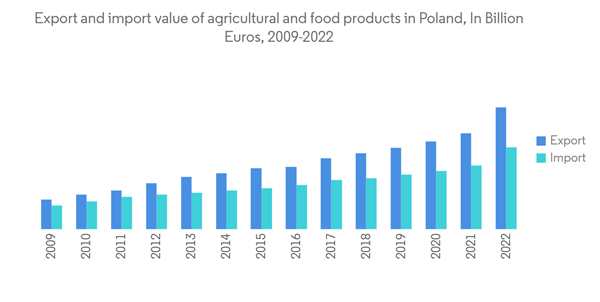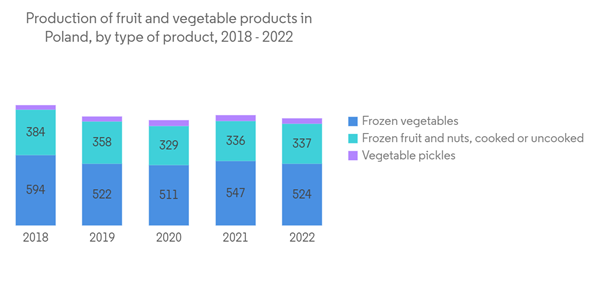The Poland Cold Chain Logistics Market size is estimated at USD 3 billion in 2024, and is expected to reach USD 4.94 billion by 2029, growing at a CAGR of 10.43% during the forecast period (2024-2029).
Poland is one of the leading agri-food producers and one of Europe’s largest producers. As the second-largest country in Central Europe, Poland is an attractive market for all kinds of food professionals, opening up a huge potential for the cold chain logistics industry.
The two major transport corridors connecting Poland to Northern Europe and Central Asia make it a regional food hub, extending beyond the European Union’s borders to the Mediterranean, North Africa, and Asia. The country’s favorable location makes it fully accessible to the well-served road, air, and rail links.
The energy crisis caused by the Russian invasion of Ukraine has caused households and businesses to brace themselves for an unprecedented winter of energy prices. Many businesses, not least those in the cold chain industries, are already struggling with these rising costs.
With an annual investment of around USD 2 billion in new warehouses, storage capacity is set to increase significantly in the coming years. In addition, several factors are increasing the demand for transportation solutions in Poland, such as food, nuclear power plants, and temperature-sensitive machinery and equipment. GLP, one of the investors and logistics warehouse and distribution park builders, launched two new logistics facilities in Poland on 31 March 2022. This project was part of GLP’s ongoing work in Poland. In total, GLP expects to deliver about 240,000 sq.m worth of logistics projects in the country in 2022.
Food exports are an important part of Poland's multi-billion-dollar economy. As a result, Polish exporters are constantly looking for top-notch cold chain logistics solutions, including reefer trucks, chiller equipment, and warehousing facilities.
Imports and exports of fresh, chilled, or frozen produce are a constant worry for Poland. Every year, millions of tonnes of food and beverage goods, which require refrigerated transportation, enter and leave the country.
Food exports play an important role in Poland’s multibillion-dollar economy. The country’s central European location makes it a regional food hub, with the potential to expand its reach beyond the European Union and into the Mediterranean, North African, and Asian markets. As a result, Polish companies must deliver their products intact, ready to be processed or consumed, to overseas markets.
Poland's main trade partner is Germany. Between January and October 2022, exports to Germany totaled EUR 9.7 billion (USD 10.88 billion), 26% more than the previous year. The main products exported from Poland to Germany are cigarettes, poultry meat, fish preparations, and pet food. The main products for export to Germany are mostly poultry meat, cigarettes, and grains of maize. The main products for export from Poland to the EU are mainly poultry meat, meat preparations, and fish preparations.
Year-on-year (YoY) growth of 19.5% (EUR 3.21 billion) for the year ended April 2022, according to data compiled by KOWR (National Centre for the Export of Agricultural and Food Goods). The total value of Polish exports of agricultural and food products reached EUR 14.0 billion (USD 14.90 Billion) in the year to April 2022. Poultry and bread products accounted for the largest share of Polish exports in the agricultural and food category. Animal feed followed, followed by chocolate products and cattle. Last year, the volume of Polish exports of food and agricultural products reached a new peak of EUR 37.8 billion (USD 39.58 Billion).
Ambient control is especially important for meat and dairy handling. Dairy products are sensitive to temperature as well as handling and mechanical damage during loading and unloading. On the other hand, in meat, the increased ambient temperature can lead to the growth and multiplication of harmful bacteria that can cause food poisoning at the time of consumption. Therefore, companies that produce and transport meat, fish, or dairy products are obligated to maintain the continuity of cold chain facilities with established environmental conditions throughout the whole production, storage, and delivery process.
This product will be delivered within 2 business days.
Poland is one of the leading agri-food producers and one of Europe’s largest producers. As the second-largest country in Central Europe, Poland is an attractive market for all kinds of food professionals, opening up a huge potential for the cold chain logistics industry.
The two major transport corridors connecting Poland to Northern Europe and Central Asia make it a regional food hub, extending beyond the European Union’s borders to the Mediterranean, North Africa, and Asia. The country’s favorable location makes it fully accessible to the well-served road, air, and rail links.
The energy crisis caused by the Russian invasion of Ukraine has caused households and businesses to brace themselves for an unprecedented winter of energy prices. Many businesses, not least those in the cold chain industries, are already struggling with these rising costs.
With an annual investment of around USD 2 billion in new warehouses, storage capacity is set to increase significantly in the coming years. In addition, several factors are increasing the demand for transportation solutions in Poland, such as food, nuclear power plants, and temperature-sensitive machinery and equipment. GLP, one of the investors and logistics warehouse and distribution park builders, launched two new logistics facilities in Poland on 31 March 2022. This project was part of GLP’s ongoing work in Poland. In total, GLP expects to deliver about 240,000 sq.m worth of logistics projects in the country in 2022.
Food exports are an important part of Poland's multi-billion-dollar economy. As a result, Polish exporters are constantly looking for top-notch cold chain logistics solutions, including reefer trucks, chiller equipment, and warehousing facilities.
Imports and exports of fresh, chilled, or frozen produce are a constant worry for Poland. Every year, millions of tonnes of food and beverage goods, which require refrigerated transportation, enter and leave the country.
Food exports play an important role in Poland’s multibillion-dollar economy. The country’s central European location makes it a regional food hub, with the potential to expand its reach beyond the European Union and into the Mediterranean, North African, and Asian markets. As a result, Polish companies must deliver their products intact, ready to be processed or consumed, to overseas markets.
Poland Cold Chain Logistics Market Trends
Poland’s Foreign Trade in Agri-Food Products
Revenue on international sales increased by 27.3% year-on-year to PLN 183.2 billion (USD 46.15 Billion) in the first ten months of 2022. The higher growth rate compared to 2021 confirms the success of Polish entrepreneurs in the global agri-food market. Exporting agri-food allows the management of surplus food produced in Poland. It is a major source of income for the Polish agro-food industry and has a positive impact on the economy. On the other hand, agri-food imports increased by 29.6% to PLN 122 billion (USD 30.73 billion) in the first 10 months of 2022. The positive trade balance amounted to PLN 13.0 billion (USD 3.27 billion), compared to PLN 61 billion (USD 15.37 billion) in the same period of 2021.Poland's main trade partner is Germany. Between January and October 2022, exports to Germany totaled EUR 9.7 billion (USD 10.88 billion), 26% more than the previous year. The main products exported from Poland to Germany are cigarettes, poultry meat, fish preparations, and pet food. The main products for export to Germany are mostly poultry meat, cigarettes, and grains of maize. The main products for export from Poland to the EU are mainly poultry meat, meat preparations, and fish preparations.
Supply chain demand for temperature and humidity control
The main determinant of Polish feed consumption is meat consumption, which is responsible for most of the price variations. In volume terms, meat production and consumption are stable, which means that feed demand is stable.Year-on-year (YoY) growth of 19.5% (EUR 3.21 billion) for the year ended April 2022, according to data compiled by KOWR (National Centre for the Export of Agricultural and Food Goods). The total value of Polish exports of agricultural and food products reached EUR 14.0 billion (USD 14.90 Billion) in the year to April 2022. Poultry and bread products accounted for the largest share of Polish exports in the agricultural and food category. Animal feed followed, followed by chocolate products and cattle. Last year, the volume of Polish exports of food and agricultural products reached a new peak of EUR 37.8 billion (USD 39.58 Billion).
Ambient control is especially important for meat and dairy handling. Dairy products are sensitive to temperature as well as handling and mechanical damage during loading and unloading. On the other hand, in meat, the increased ambient temperature can lead to the growth and multiplication of harmful bacteria that can cause food poisoning at the time of consumption. Therefore, companies that produce and transport meat, fish, or dairy products are obligated to maintain the continuity of cold chain facilities with established environmental conditions throughout the whole production, storage, and delivery process.
Poland Cold Chain Logistics Industry Overview
The cold chain logistics market in Poland is highly fragmented, with a mixture of international and domestic players. The majority of the imported and exported products must be tracked in refrigerated transport. The leading players in the cold chain market in Poland are Green Yard Logistics, Pago Logistics, Frigo Logistics, New Cold Logistics, and Eco Containers. After the pandemic, the market started to recover and started to grow positively.Additional Benefits:
- The market estimate (ME) sheet in Excel format
- 3 months of analyst support
This product will be delivered within 2 business days.
Table of Contents
1 INTRODUCTION
2 RESEARCH METHODOLOGY
4 MARKET INSIGHTS
5 MARKET SEGMENTATION
6 COMPETITIVE LANDSCAPE
8 APPENDIX
Methodology

LOADING...










